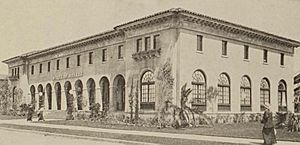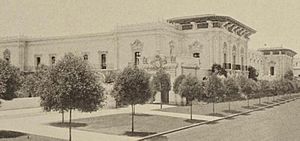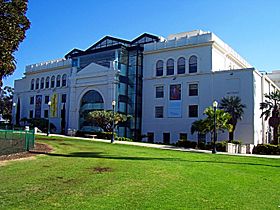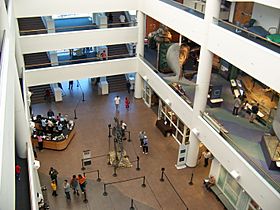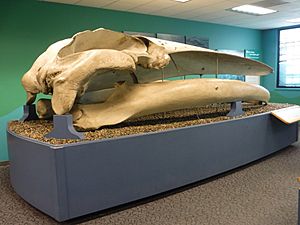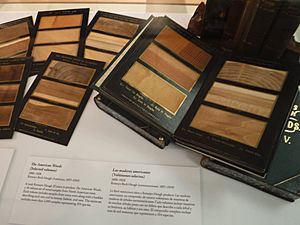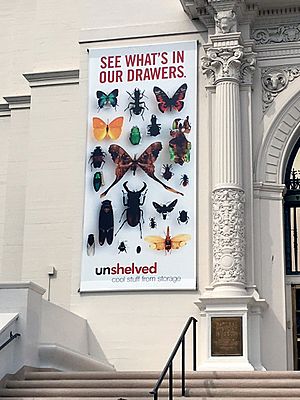San Diego Natural History Museum facts for kids
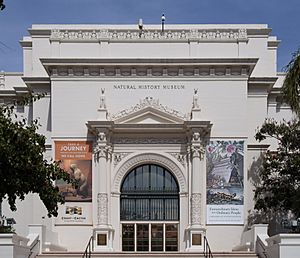 |
|
| Lua error in Module:Location_map at line 420: attempt to index field 'wikibase' (a nil value). | |
| Established | 1874 |
|---|---|
| Location | 1788 El Prado, Balboa Park San Diego, CA 92101 United States |
| Type | Natural history museum |
| Public transit access | SDMTS |
The San Diego Natural History Museum is a cool place to explore nature and science in Balboa Park, San Diego, California. It started way back in 1874 as the San Diego Society of Natural History. This makes it the second oldest science organization west of the Mississippi River and the oldest in Southern California. The museum moved into its current building on January 14, 1933. Later, in April 2001, a big new part was added, which doubled the space for all the amazing exhibits.
Museum History
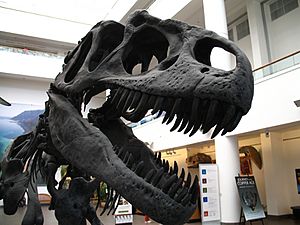
The San Diego Natural History Museum grew from the San Diego Society of Natural History, which began on October 9, 1874. A group of people including George W. Barnes and Daniel Cleveland started it. It is the oldest science group in southern California.
In its early years, the Society was a main source of scientific knowledge for the growing community. People wanted to learn about the area's natural resources. Early members helped create the Torrey Pines State Natural Reserve in 1885 and Anza-Borrego Desert State Park. They also supported the Zoological Society of San Diego.
In 1910, the Society hired Kate Stephens to care for its collections. She was an expert on sea and land snails and shells. Her husband, Frank Stephens, who studied mammals and birds, gave over 2,000 bird and mammal items to the Society. In 1912, Kate and Frank Stephens set up the Society's first museum exhibits at the Cecil Hotel. People could visit them on certain afternoons.
Moving to Balboa Park
After the 1915 Panama–California Exposition in Balboa Park, people wanted to use the empty buildings. In 1917, the Society bought the Nevada State Building for $500. They moved their growing collections and library there in February 1917. This is how the San Diego Natural History Museum officially began. Frank Stephens was the museum's first director from 1917 to 1920. The museum's goal was "to educate and help people know and love nature." They used their collections to create learning programs for schools.
However, many of the Exposition buildings were not meant to last. The Nevada building was not strong enough. The museum then moved to the 1915 Foreign Arts Building in 1920. When that became too small, they expanded into the 1916 Canadian Building. This new space opened to the public on December 9, 1922.
A Permanent Home
From 1922 until 1946, Clinton Gilbert Abbott was the museum's director. During his time, the museum was able to build a long-lasting home. Other important naturalists like Guy Fleming and Laurence M. Huey also worked there.
In 1925, a fire nearby made people worry about the safety of the museum's buildings. Community leaders realized a permanent, fire-proof, and earthquake-proof museum was needed. Ellen Browning Scripps was a big supporter and helped fund the new building.
In 1932, William Templeton Johnson, a famous San Diego architect, designed the new museum building in Balboa Park. He had designed other important buildings in the city. The museum building mixed Spanish and Moorish styles. It had yellow and blue tiles under a row of arches.
The new building was possible because of a $125,000 gift from Ellen Browning Scripps and money from public donations. But during the Great Depression, they couldn't raise all the money needed. So, only the first part of the building was built. The north and east walls were left plain, waiting for future expansion. The new $175,000 Natural History Museum building officially opened on January 14, 1933.
World War II and Beyond
On March 8, 1943, the United States Navy took over the museum building to use as a hospital during World War II. It became a ward for infectious diseases. Some changes were made, like adding an elevator for hospital beds. These features are still used today. The Navy's use of the building caused some damage to the collections and the building itself. Many valuable exhibits were quickly packed and moved to 32 different places. Large exhibits that couldn't be moved were put into the north wing.
When the staff could finally return on July 1, 1949, major repairs began. The museum decided to focus its collections on the southwestern United States and northern Mexico. The museum continued to grow as San Diego grew after the war. In 1974, the American Alliance of Museums officially recognized the museum.
Modern Expansion
In 1991, Michael Hager became the museum's President and CEO. He helped the museum focus its collections on southern and Baja California. This led to the creation of the Biodiversity Research Center of Southern California. It also led to a big project to expand the museum.
In April 2001, new construction more than doubled the size of the 1933 building. It grew from about 65,000 square feet to 150,000 square feet. The entrance got a new modern look with a glassed atrium. This expansion also created new space for the museum's research, education, and office work. In 2016, Judy Gradwohl became the first woman to lead the museum in its nearly 150-year history. A Paleontology Center opened in the basement in June 2025, showing off amazing fossils.
In December 2009, the San Diego Natural History Museum received a special award called LEED Certification. This award means the building is environmentally friendly and uses energy wisely. It was one of the oldest private museums to get this award.
Exhibitions and Programs
With the new wing, the museum created areas for permanent exhibits and five new exhibition halls. They also added the Charmaine and Maurice Kaplan Theater, which has a huge 56-foot screen and a 3D projector.
Current Exhibitions

Fossil Mysteries is a fun, interactive exhibit. It tells the story of southern California and Baja California, Mexico, over 75 million years, through fossils. With many fossils, dioramas (3D scenes), murals, and models, the exhibit shows how life changed from the age of dinosaurs to the Ice Ages.
The Coast to Cactus in Southern California exhibit, opened in 2015, shows off the many different kinds of plants and animals in the region. This permanent exhibit won an award in 2016 for its "Overall Excellence."
In 2016, the museum created the Eleanor and Jerome Navarra Special Collections Gallery in its Research Library. This gallery has a new permanent exhibit called Extraordinary Ideas From Ordinary People: A History of Citizen Science. This exhibit shows how everyday people have helped with scientific discoveries.
In 2017, the museum opened Unshelved – Cool Stuff from Storage. This exhibit lets visitors see behind the scenes. It displays carefully preserved items from the museum's research collections, like birds, mammals, plants, insects, reptiles, and minerals. It's like getting a "backstage" pass to the museum's amazing hidden treasures.
Other Notable Exhibitions
In 2003, the museum showed many paintings from its collection in an exhibit called Plant Portraits: The California Legacy of A.R. Valentien. This exhibit displayed 80 of the museum's 1,092 watercolors of California plants. These were painted in the early 1900s by Albert R. Valentien. This show won an award in 2004 and traveled to other museums until 2009.
In 2007–2008, a collection of the Dead Sea Scrolls was on display. Ten of these ancient scrolls were shown to the public for the very first time. Nearly 400,000 people visited this exhibit, which was a record for the museum.
Research and Collections
The museum is a major place for studying biodiversity in the region. It does field research in many science areas. It also provides important information about where plants and animals live. This helps protect the environment and plan land use.
Biodiversity Research Center of the Californias
The museum's research group, the Biodiversity Research Center of the Californias (BRCC), goes on expeditions and does field research in Southern California and the Baja California peninsula. Scientists from different fields work together from the United States and Mexico. These trips help grow the museum's collections, protect nature, manage natural resources, and teach about the environment. The BRCC started in 2002 to focus on regional biology, biodiversity, and geology.
Some expeditions include a study of the Sierra Cacachilas from 2013 to 2016. This trip led to the discovery of a new spider species, Califorctenus cacachilensis. Another study looked at the plants and animals of Isla Guadalupe in 2000. The San Jacinto Resurvey, from 2008 to 2010, compared how wildlife in the San Jacinto Mountains changed over a century. The Flying Squirrel Study helps find out where the San Bernardino Flying Squirrel lives. It also uses the iNaturalist app, where citizen scientists can upload their observations to help scientists.
Research Departments
The museum has several departments that do research. These include Birds and Mammals, Botany, Entomology, Herpetology, and Paleontology. Other departments, like Marine Invertebrates and Mineralogy, have important collections that scientists often use.
Birds and Mammals
This department started with the collection of Frank Stephens in 1910. Now, it has examples of 90% of the world's bird families and 58% of its mammal families. The museum also stores specimens from the San Diego Zoo. The department's field work has led to two major guides: The San Diego County Bird Atlas (2004) and The San Diego County Mammal Atlas (2017). Recent work studies how environmental changes affect bird populations in Southern California.
Botany
The Botany Department collects plants in San Diego County and Baja California. Its herbarium (plant collection) has 250,000 specimens of native and wild plants from the southwestern United States and northwestern Mexico. It has many marine algae specimens from the eastern North Pacific. The collection is especially rich in Crassulaceae (succulents) and Cactaceae (cacti). Recent work includes research on plant diversity in the region. The department offers online access to its records through two websites: Flora of Baja California and the San Diego County Plant Atlas.
Entomology
The Entomology Department has over 900,000 insect specimens. The insect collection is very strong in Coleoptera (beetles) and Lepidoptera (butterflies and moths). It also has important collections of Diptera (flies), Hymenoptera (ants, bees, wasps), and Neuroptera (lacewings). The collection includes over 200 "primary types" (the first specimen used to describe a species) and 500 "paratypes" (additional specimens). There are also 15 "holotypes" (the single specimen used to describe a species) of Arachnids, mostly tarantulas. These collections are often used by local government departments and environmental consultants.
Herpetology
The Herpetology Department has over 76,000 cataloged specimens of amphibians and reptiles. This includes one of the largest collections of rattlesnakes in the world. The collection has species from the local region and from around the world, especially from the southwest United States, northwest Mexico, and global islands. The department hosts the Amphibian and Reptile Atlas of Peninsular California. This project uses both museum data and observations from citizen scientists to study biodiversity.
Paleontology
The Paleontology Department's collections include fossil vertebrates (animals with backbones), invertebrates (animals without backbones), and plants. These fossils are mainly from sites in southern California and northern Baja California, Mexico, dating from the Mesozoic to Cenozoic eras. The department has an online database with over 137,000 species lots, representing 1.4 million specimens. Recent work by the department includes dating the Cerutti Mastodon site.
Research Library
The Library has a complete natural history reference collection, rare books, and a map collection. It also has an art collection with beautiful botanical watercolors by A. R. Valentien and wildlife paintings by George Miksch Sutton. The Library's archives include many historical photos and important field notes. These include notes from herpetologist Laurence Klauber and mammalogists Frank Stephens and Laurence M. Huey. The library director curates the museum's permanent exhibition Extraordinary Ideas from Ordinary People: A History of Citizen Science, which uses the library's rich resources.
San Diego Zooarchaeology Laboratory
The San Diego Zooarchaeology Laboratory (SDZL) identifies animal bones found at archaeological sites. These sites are in San Diego County, the western United States, and the ancient Near East. The lab uses the museum's scientific collections for comparison. Started in 2010, the SDZL collections have over 46,000 bird specimens and 22,650 mammal specimens. They have 7,000 complete bird skeletons and over 1,000 complete mammal skeletons. The lab helps understand how animals were used in ancient times. It also trains students and volunteers in zooarchaeology.
Publications
The museum has published scientific papers since 1905. This shows its long history of research into the past geology and current biodiversity of western North America. All of the museum's scientific publications are available online. The journal Transactions of San Diego Society of Natural History came before the current Proceedings of the San Diego Society of Natural History. The museum also publishes online atlas projects, like the Amphibian and Reptile Atlas of Peninsular California and the Plant Atlas of San Diego County. Recent publications include the Bird Atlas of San Diego County (2004) and the Mammal Atlas of San Diego County (2017).
See also
 In Spanish: Museo de Historia Natural de San Diego para niños
In Spanish: Museo de Historia Natural de San Diego para niños


